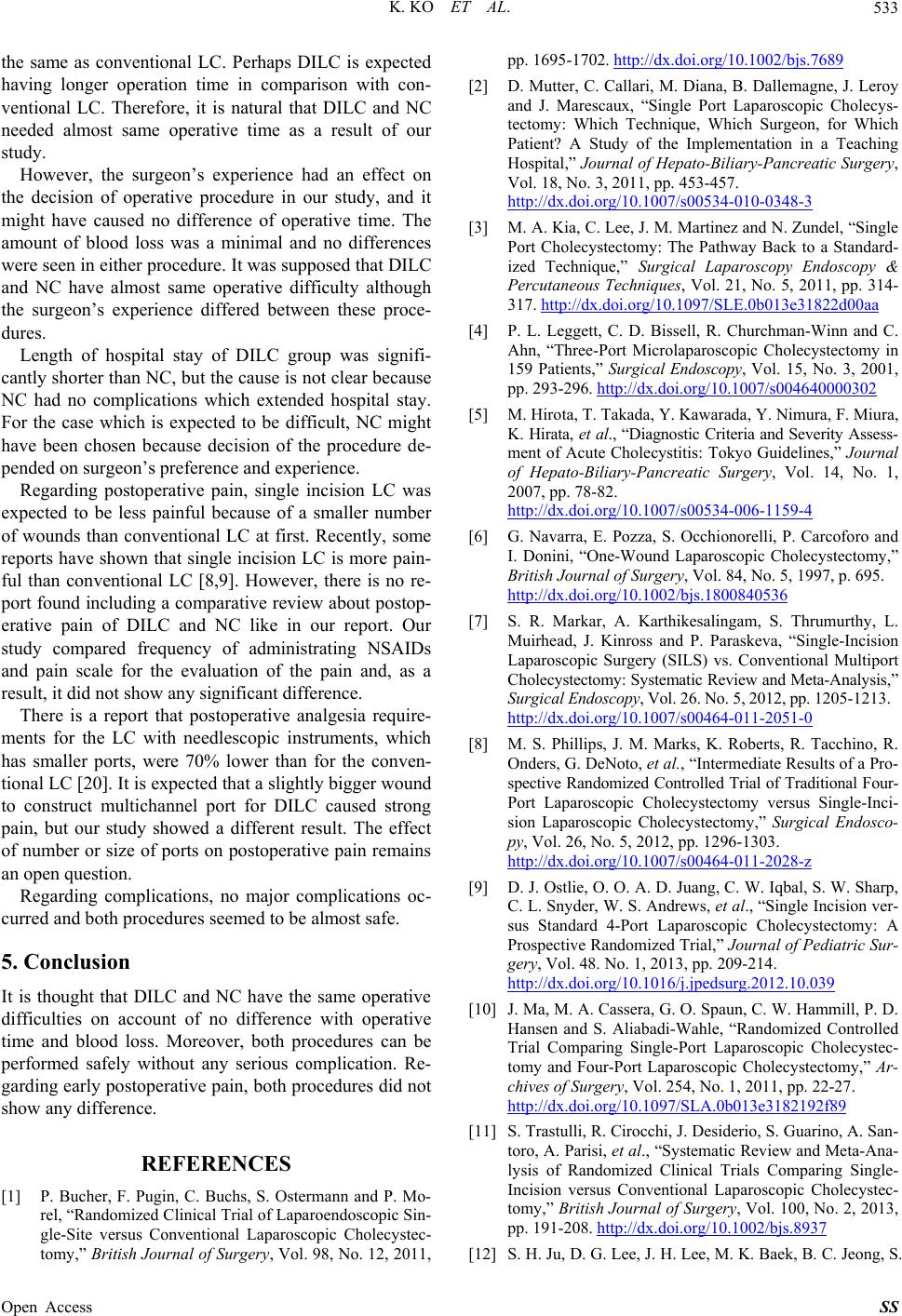
K. KO ET AL. 533
the same as conventional LC. Perhaps DILC is expected
having longer operation time in comparison with con-
ventional LC. Therefore, it is natural that DILC and NC
needed almost same operative time as a result of our
study.
However, the surgeon’s experience had an effect on
the decision of operative procedure in our study, and it
might have caused no difference of operative time. The
amount of blood loss was a minimal and no differences
were seen in either procedure. It was supposed that DILC
and NC have almost same operative difficulty although
the surgeon’s experience differed between these proce-
dures.
Length of hospital stay of DILC group was signifi-
cantly shorter than NC, but th e cause is not clear because
NC had no complications which extended hospital stay.
For the case which is expected to be difficult, NC might
have been chosen because decision of the procedure de-
pended on surgeon’s preference and experience.
Regarding postoperative pain, single incision LC was
expected to be less painful because of a smaller number
of wounds than conventional LC at first. Recently, some
reports have shown that single incision LC is more pain-
ful than conventional LC [8,9]. However, there is no re-
port found including a comparative review about postop-
erative pain of DILC and NC like in our report. Our
study compared frequency of administrating NSAIDs
and pain scale for the evaluation of the pain and, as a
result, it did not show any significant difference.
There is a report that postoperative analgesia require-
ments for the LC with needlescopic instruments, which
has smaller ports, were 70% lower than for the conven-
tional LC [20]. It is expected that a slightly bigger wound
to construct multichannel port for DILC caused strong
pain, but our study showed a different result. The effect
of number or size of ports on postoperative pain remains
an open que st ion.
Regarding complications, no major complications oc-
curred and both procedures seemed to be almost safe.
5. Conclusion
It is thought that DILC and NC have the same operative
difficulties on account of no difference with operative
time and blood loss. Moreover, both procedures can be
performed safely without any serious complication. Re-
garding early postoperative pain, both procedures did not
show any difference.
REFERENCES
[1] P. Bucher, F. Pugin, C. Buchs, S. Ostermann and P. Mo-
rel, “Randomized Clinical Trial of Laparoendoscopic Sin-
gle-Site versus Conventional Laparoscopic Cholecystec-
tomy,” British Journal of Surgery, Vol. 98, No. 12, 2011,
pp. 1695-1702. http://dx.doi.org/10.1002/bjs.7689
[2] D. Mutter, C. Callari, M. Diana, B. Dallemagne, J. Leroy
and J. Marescaux, “Single Port Laparoscopic Cholecys-
tectomy: Which Technique, Which Surgeon, for Which
Patient? A Study of the Implementation in a Teaching
Hospital,” Journal of Hepato-Biliary-Pancreatic Surgery,
Vol. 18, No. 3, 2011, pp. 453-457.
http://dx.doi.org/10.1007/s00534-010-0348-3
[3] M. A. Kia, C. Lee, J. M. Martinez and N. Zundel, “Single
Port Cholecystectomy: The Pathway Back to a Standard-
ized Technique,” Surgical Laparoscopy Endoscopy &
Percutaneous Techniques, Vol. 21, No. 5, 2011, pp. 314-
317. http://dx.doi.org/10.1097/SLE.0b013e31822d00aa
[4] P. L. Leggett, C. D. Bissell, R. Churchman-Winn and C.
Ahn, “Three-Port Microlaparoscopic Cholecystectomy in
159 Patients,” Surgical Endoscopy, Vol. 15, No. 3, 2001,
pp. 293-296. http://dx.doi.org/10.1007/s004640000302
[5] M. Hirota, T. Takada, Y. Kawarada, Y. Nimura, F. Miura,
K. Hirata, et al., “Diagnostic Criteria and Severity Assess-
ment of Acute Cholecystitis: Tokyo Guidelines,” Journal
of Hepato-Biliary-Pancreatic Surgery, Vol. 14, No. 1,
2007, pp. 78-82.
http://dx.doi.org/10.1007/s00534-006-1159-4
[6] G. Navarra, E. Pozza, S. Occhionorelli, P. Carcoforo and
I. Donini, “One-Wound Laparoscopic Cholecystectomy,”
British Journal of Surgery, Vol. 84, No. 5, 1997, p. 695.
http://dx.doi.org/10.1002/bjs.1800840536
[7] S. R. Markar, A. Karthikesalingam, S. Thrumurthy, L.
Muirhead, J. Kinross and P. Paraskeva, “Single-Incision
Laparoscopic Surgery (SILS) vs. Conventional Multiport
Cholecy stectomy: Systematic Review and Meta-Analysis,”
Surgical Endoscopy, Vol. 26. No. 5, 2012, pp. 1205-1213.
http://dx.doi.org/10.1007/s00464-011-2051-0
[8] M. S. Phillips, J. M. Marks, K. Roberts, R. Tacchino, R.
Onders, G. DeNoto, et al., “Intermediate Results of a Pro-
spective Randomized Controlled Trial of Traditional Four-
Port Laparoscopic Cholecystectomy versus Single-Inci-
sion Laparoscopic Cholecystectomy,” Surgical Endosco-
py, Vol. 26, No. 5, 2012, pp. 1296-1303.
http://dx.doi.org/10.1007/s00464-011-2028-z
[9] D. J. Ostlie, O. O. A. D. Juang, C. W. Iqbal, S. W. Sharp,
C. L. Snyde r, W. S. Andrews, et al., “Single Incision ver-
sus Standard 4-Port Laparoscopic Cholecystectomy: A
Prospective Randomized Trial,” Journal of Pediatric Sur-
gery, Vol. 48. No. 1, 2013, pp. 209-214.
http://dx.doi.org/10.1016/j.jpedsurg.2012.10.039
[10] J. Ma, M. A. Cassera, G. O. Spaun, C. W. Hammill, P. D.
Hansen and S. Aliabadi-Wahle, “Randomized Controlled
Trial Comparing Single-Port Laparoscopic Cholecystec-
tomy and Four-Port Laparoscopic Cholecystectomy,” Ar-
chives of Surgery, Vol. 254, No. 1, 2011, pp. 22-27.
http://dx.doi.org/10.1097/SLA.0b013e3182192f89
[11] S. Trastulli, R. Cirocchi, J. Desiderio, S. Guarino, A. San-
toro, A. Parisi, et al., “Systematic Review and Meta-Ana-
lysis of Randomized Clinical Trials Comparing Single-
Incision versus Conventional Laparoscopic Cholecystec-
tomy,” British Journal of Surgery, Vol. 100, No. 2, 2013,
pp. 191-208. http://dx.doi.org/10.1002/bjs.8937
[12] S. H. Ju, D. G. Lee, J. H. Lee, M. K. Baek, B. C. Jeong, S.
Open Access SS